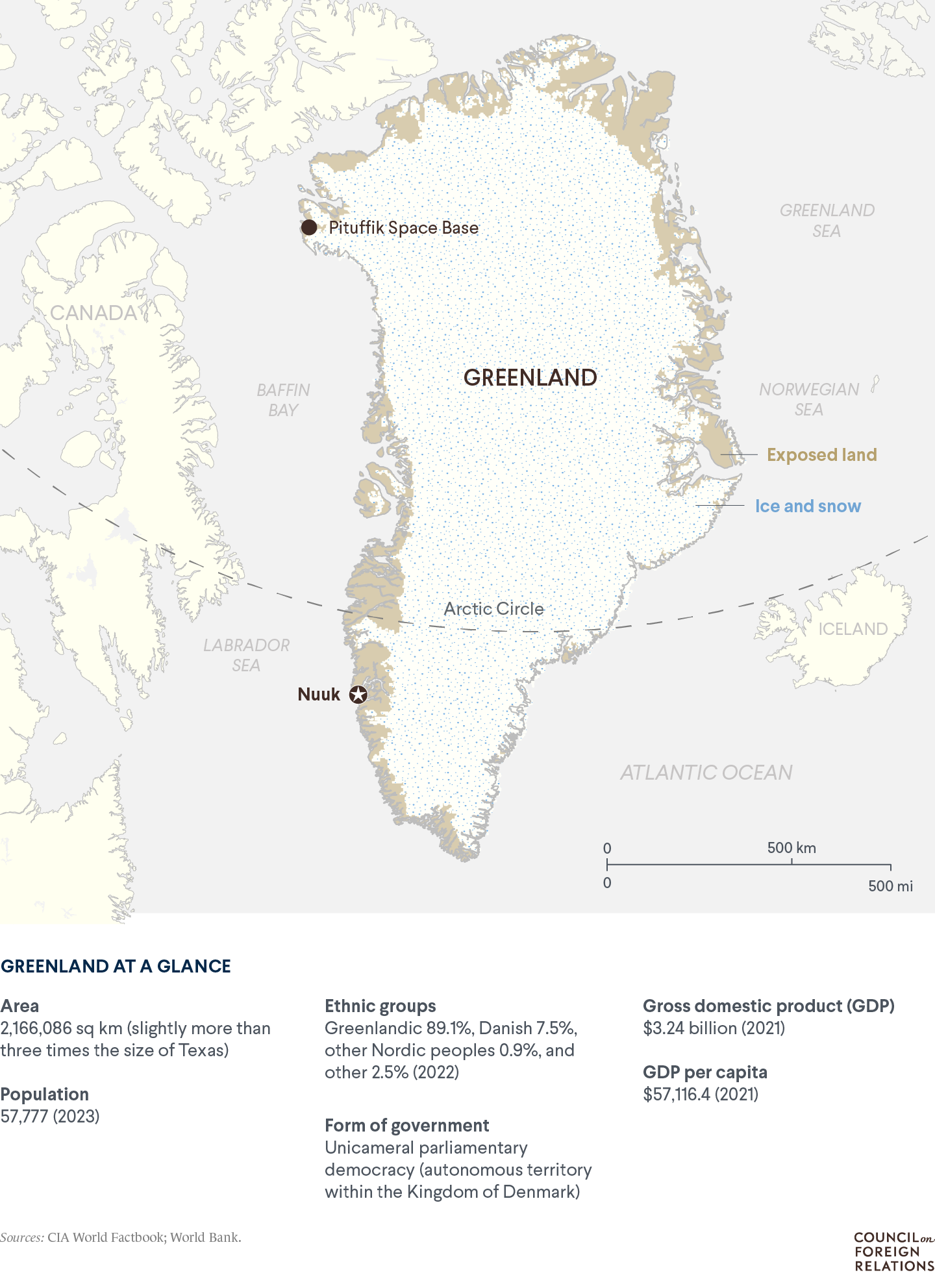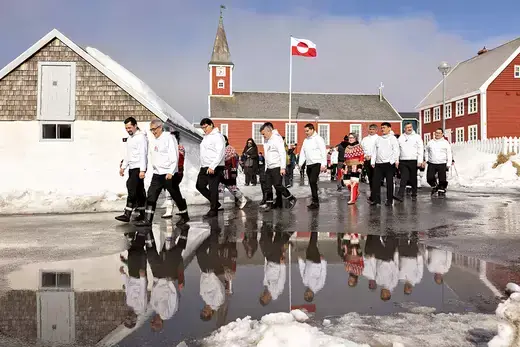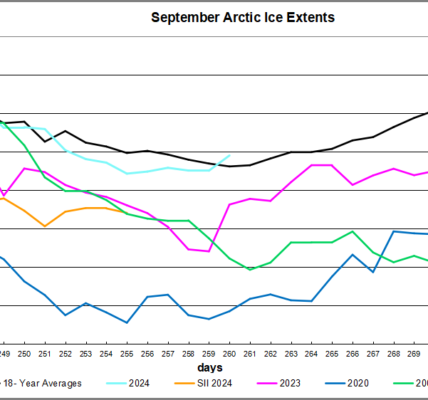Climate change is fueling geopolitical competition in the Arctic. An independent Greenland could play an important role in years to come.
Greenland has been part of Denmark since 1721, but a draft constitution unveiled in April 2023 is the strongest indicator yet of a looming separation. With competition heating up over the region’s resources, including oil and gas reserves and crucial rare earth minerals, what could an independent Greenland mean for the Arctic?
What is Greenland’s status?
Greenland is a self-governing Danish territory that gained autonomy in 1979, though the island still relies heavily on Denmark for financial support, as well as management of its monetary policy, defense, and foreign relations. Greenlandic representatives join Danish delegations at the United Nations, North Atlantic Treaty Organization (NATO), and European Union (EU). While Greenland has overseas country and territory status with the EU, the island is not a member.
The movement for Greenland’s independence has intensified over the past two decades. In a 2008 referendum, 75 percent of Greenlandic citizens voted in favor of the Act on Greenland Self-Government, which expanded the island’s control over the police, courts, and coast guard, among dozens of other areas. Under the act, Greenland can achieve full independence via a referendum with approval from the Danish Parliament. In April 2023, a constitutional commission presented Greenland’s parliament, the Inatsisartut, with the island’s first draft constitution.

Why would Greenland’s independence matter?
Politics. Analysts say an independent Greenland would be unlikely to completely cut ties with Denmark. While Greenlandic Prime Minister Múte Bourup Egede supports independence, he has emphasized a gradual approach. Even members of Greenland’s strongest and most vocal pro-independence party, Naleraq, have indicated a desire for continued cooperation with Denmark. Still, independence would put an end to the long-standing confusion over how decision-making is divided between Nuuk and Copenhagen.
Economics. Greenland’s economy is among the smallest in the world. Despite efforts to diversify, Greenland is still reliant on domestic fisheries as its primary revenue source, while an annual subsidy of more than $500 million from Denmark accounts for 20 percent of the island’s economy and over half of its public budget. With a population of only fifty-seven thousand, the island’s limited labor pool is also a concern.
But there would also be opportunities for growth. The Greenlandic national freight company—which is responsible for all local and international shipping—recently moved its headquarters from Denmark to Greenland and is poised to expand beyond the North Atlantic [PDF]. Warming temperatures are making rare earth metal deposits more accessible, drawing the eye of foreign investors, including both China and Western countries keen to reduce their dependence on rivals. The island is also believed to have large oil and natural gas reserves, though the government ceased issuing new licenses for exploration in 2021, citing climate concerns and low profitability projections. Meanwhile, Egede has expressed a desire to grow the tourism industry, which could test the island’s limited infrastructure.
Military. Denmark is currently responsible for Greenland’s defense, as the island has no military of its own. Greenlanders can join the Danish armed forces, whose presence on the island is limited to a few aircraft, ships, and a dog-sled patrol. Greenland also hosts the Danish Joint Arctic Command and U.S. military forces, and it is under NATO protection via Denmark. While the future security arrangements of an independent Greenland remain unclear, advocates have pointed to the example of Iceland, which also used to be under Danish control and is now a NATO member.

What are the stakes in the Arctic?
Climate change is accelerating geopolitical competition in the Arctic as warming temperatures make it easier to access previously unreachable natural resources, including gold and iron ore. Large deposits of rare earth metals, essential for the production of smart technology and electric vehicles, are believed to lay under Greenland’s ice. Arctic nations, meanwhile, are already pursuing Arctic Ocean oil and gas reserves, which could account for between 10 and 30 percent of the world’s undiscovered fossil fuels.
Rapid warming in the Arctic is also opening up shipping lanes, notably in the Bering Strait and the Greenland-Iceland-United Kingdom Gap. These two passages are not only major strategic military chokeholds, but they could also cut the shipping distances of vessels currently using the Panama and Suez Canals by up to half.

How have other Arctic powers responded?
Of the eight countries with territory in the Arctic, the United States has played the biggest role in Greenland after Denmark. It has had a military presence there since World War II, centered on the Pituffik Space Base, Washington’s northernmost military installation and a central piece of its ballistic missile warning system. With successive U.S. administrations strengthening ties with Greenland, experts see independence as unlikely to upend the relationship. Despite a chilly reception to his desire to buy the island from Denmark, President Donald Trump reopened the U.S. consulate in Greenland and committed to giving it more than $12 million in aid. Under the Joe Biden administration, Washington signed a twelve-year, $3.95 billion deal to retain forces on the island, and it appointed the first U.S. ambassador-at-large to the Arctic.
Western powers have also raised alarm over increasing Russian and Chinese influence in the region. Russia has claims to vast portions of the Arctic, which include some parts of Greenland’s exclusive economic zone, and its significant military presence in the region has drawn concern from NATO members. Beijing also has its eye on the Arctic, highlighted by its increased investment in regional initiatives over the last decade. Some experts say that Greenland could leverage concern over rising Chinese or Russian influence to garner greater support from Western powers.
What’s next?
The next Greenlandic parliamentary election is currently scheduled for 2025 and could signal whether the independence movement is set to accelerate: according to a 2019 poll, more than two-thirds of Greenland’s adult population support it. Still, many of the 2023 draft constitution’s provisions remain unclear.
Meanwhile, the debate sits atop major geopolitical fault lines. Accelerating climate change is “amplifying competition in the Arctic as never before, opening the region to greater commercial and strategic jostling just at a moment when Russia, China and the West are all seeking to expand their military presence there,” writes journalist Steven Erlanger for the New York Times.
By Joseph Wehmeyer, an editorial intern at CFR. Michael Bricknell and Will Merrow created the graphics for this In Brief.




